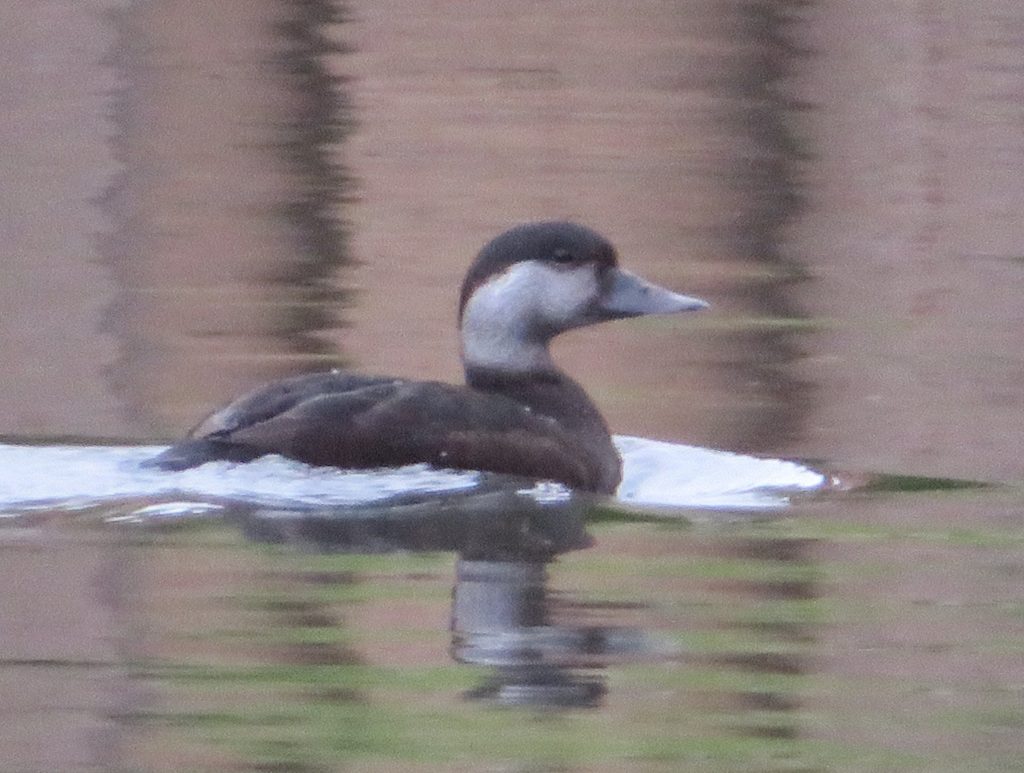Common Scoter, Melanitta nigra
Local status: Scarce passage migrant
The commonest seaduck around the UK coast and large numbers can be seen off the Yorkshire coast both on passage and in winter. Common Scoters are well known for their overland migrations, particularly during spring and this phenomenon explains their frequency in the York area during this season. Most spring passage occurs in April. In total, birds have been recorded in nine months of the year with February, July and September blank. Castle Howard and Wheldrake Ings are the most frequently visited sites, perhaps due to the scarcity of water at other localities during April. Dringhouses Pond, York has attracted records, proving that regular visits to a site can pay dividends. Most records have involved single birds, but some large parties have been involved, notably the 85 that flew into Castle Howard in November 1983, which must have been an amazing sight.
During the covid lockdowns of 2020 and with increasing use of social media to share information and with a lack of traffic noise during lockdown, flocks were tracked across the country as they moved from the west to east coast allowing observers to hear flocks calling as they passed over the York area. These are thought to perhaps involve birds that had wintered off the North Wales coast, moving inland over the Mersey and Wirral area, before cutting across the Peak District to the Humber and Vale of York and then out to the North Sea. These nocturnal migrations have become an annual feature.
Massive Common Scoter movement takes place – BirdGuides

Records prior to 2021
2021: Angram pond, Riccall, 28th November. female
2021: 14th October, South Duffield. nocturnal flock
2021: 7th August & 5th September, Elvington. nocturnal flocks
2021: 7th August, Acomb. A flock passed west high
2021: 23rd July, Heslington East. five
2021: 26th April, Heslington East. one
2021: 21st April, River Derwent south of Bubwith
2021: 13th April, Naburn Ings. female

2021: 9th to 13th April, North Duffield Carrs. female
2021: 9th to 13th April, Wheldrake Ings. female
2021: 8th April, LDV. two nocturnal flocks
2021: 7th April, Elvington. nocturnal flocks
2021: 29th March, Elvington. nocturnal flocks
2021: 26th March, Rawcliffe. two nocturnal flocks
2021: 24th March, Bishopthorpe and York. nocturnal flocks
2021: 22nd March, LDV and Clifton. nocturnal flocks
2021: 21st March, nocturnal flocks: LDV (200 passed over), Bishopthorpe Road, Bishopthorpe, Fulford, Hemingbrough and
Woodthorpe
2021: 18th March, Fulford. nocturnal flock
2021: 17th March, Elvington. nocturnal flock
2021: North Duffield, 24th February. three nocturnal flocks
2021: Hemingbrough Brick Pits, 22nd February. three (two drakes)
2021: Clifton Ings, 7th & 8th February. three drakes

2020: All records were of nocturnal flocks & came during the period 30th March to 6th April.
2020: 6th April: Stamford Bridge
2020: 4th April: Thorganby, Acomb and Malton
2020: 3rd April: Copmanthorpe, Fulford (two flocks), Woodthorpe, Heworth, Sherburn in Elmet, Osbaldwick, Holgate, Bishopthorpe, Riccall, Acaster Malbis, Acomb, Bolton Percy, Clifton, Seaton Ross, Gilling.
2020: 2nd April: Acomb (three flocks), Clifton, North Duffield, Elvington, Thorganby and Fulford (four flocks), Bishopthorpe (five flocks), Haxby (three flocks), Haxby (three flocks), Wheldrake (15 flocks), Heworth (two flocks), Holgate, Rawcliffe, Bolton Percy, Copmanthorpe
2020: 1st/2nd April: Wheldrake (19 flocks), Hemingbrough (several flocks), Poppleton, Acomb, Elvington, Poppleton, Rowntree Park, Hull Road Park, Bishopthorpe, Hessay
2020: Hemingbrough, Wheldrake village & Hessay 31st March/1st April. several flocks
2020: Clifton, 30th March. two flocks heard
2019: Heslington East, 29th July. female
2019: Bank Island, 5th. drake, 18th. female, 22nd. male
2018: Clifton Ings, 8th April. female
2017: Heslington East, 27th & 28th September. male
2017: Wheldrake Ings, 17th & 18th March. female
2016: Bank Island, 12th April, one pair
2016: Wheldrake Ings, 11th & 13th April. two male
2016: Wheldrake Ings, 9th April. one female
2016: North Duffield Carrs, 6th April. one male
2016: Castle Howard, 3rd April, one pair
2016: Wheldrake Ings, 20th March. one male
2016: Bank Island, 17th March, one female over
2015: Sand Hutton, 12th April. Two females.
2015: Bank Island, 20th March. Adult male.
2014: Bishopthorpe Road, York, 2nd August. 60 flew north west.
2014: Wheldrake Ings, 13th April. Female.
2013: Castle Howard, 12th to 15th September. Two. One lingered to 20th October.
2013: Heslington East, 28th to 29th May. Female.
2013: Bank Island, 18th March. Six (five males, one female).
2013: Castle Howard, 3rd to 10th March. Female.
2008: Wheldrake Ings, 28th March. Female.
2007: Sand Hutton, 15th to 19th October. Immature female.
2007: Castle Howard, 14th October. Male.
2007: North Duffield Carrs, 1st and 7th April. Male.
2006: Castle Howard, 1st April. Female.
2006: North Duffield Carrs, 31st March to 4th April. Male.
2001: Wheldrake Ings, 13th April. Male.
2001: Strensall, 12th April. Female picked up exhausted in a garden.
1999: Wheldrake Ings, 11th April. Male.
1997: Wheldrake Ings, 4th April. Male.
1994: Wheldrake Ings, 14th to 16th March. Thee (two males, one female).
1993: Castle Howard, 8th May. Male.
1990: River Ouse, Acaster Malbis, 9th December. Female.
1989: Wheldrake Ings, 14th to 15th April. Male.
1988: Dringhouses Pond, York, 15th May. Female.
1987: Newton Mask and Kexby, 8th April. Female.
1986: Ross Carrs, Selby, 22nd to 26th April. First-summer male.
1983: Castle Howard, 12th November. 85 arrived from the southwest.74 departed immediately.
1983: Holtby, early January. Picked up exhausted.
1982: Castle Howard, 20th June. 11 males.
1980: Wheldrake Ings, 27th January. One.
1980: Dringhouses Pond, York, 11th April. Pair.
1979: Castle Howard, 7th April. Six (three males, three females).
1979: Ellerton, 8th April. Three (two males, one female).
1978: Castle Howard, 16th April. Three (two males, one female).
1977: Dringhouses Pond, York, 12th August. Two immatures.
1966: Lower Derwent Valley. One
